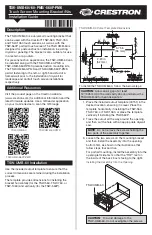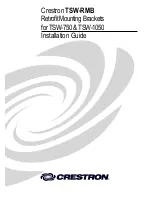
If optional stabilizer brackets are provided:
CAUTION: Tighten the stabilizer brackets until they are flush against the rack. (R006)
CAUTION: Use safe practices when lifting. (R007)
CAUTION: Do not place any object on top of a rack-mounted device unless that rack-mounted device is intended for use as a shelf.
(R008)
CAUTION: Removing components from the upper positions in the rack cabinet improves rack stability during relocation. Follow
these general guidelines whenever you relocate a populated rack cabinet within a room or building.
• Reduce the weight of the rack cabinet by removing equipment starting at the top of the rack cabinet. When possible, restore the
rack cabinet to the configuration of the rack cabinet as you received it. If this configuration is not known, you must observe the
following precautions:
– Remove all devices in the 32U position and above.
– Ensure that the heaviest devices are installed in the bottom of the rack cabinet.
– Ensure that there are little-to-no empty U-levels between devices installed in the rack cabinet below the 32U level, unless
the received configuration specifically allowed it.
• If the rack cabinet you are relocating is part of a suite of rack cabinets, detach the rack cabinet from the suite.
• If the rack cabinet you are relocating was supplied with removable outriggers they must be reinstalled before the cabinet is
relocated.
• Inspect the route that you plan to take to eliminate potential hazards.
• Verify that the route that you choose can support the weight of the loaded rack cabinet. Refer to the documentation that comes
with your rack cabinet for the weight of a loaded rack cabinet.
• Verify that all door openings are at least 760 x 2083 mm (30 x 82 in.).
• Ensure that all devices, shelves, drawers, doors, and cables are secure.
• Ensure that the four leveling pads are raised to their highest position.
• Ensure that there is no stabilizer bracket installed on the rack cabinet during movement.
• Do not use a ramp inclined at more than 10 degrees.
• When the rack cabinet is in the new location, complete the following steps:
– Lower the four leveling pads.
– Install stabilizer brackets on the rack cabinet or in an earthquake environment bolt the rack to the floor.
– If you removed any devices from the rack cabinet, repopulate the rack cabinet from the lowest position to the highest
position.
• If a long-distance relocation is required, restore the rack cabinet to the configuration of the rack cabinet as you received it. Pack
the rack cabinet in the original packaging material, or equivalent. Also lower the leveling pads to raise the casters off of the
pallet and bolt the rack cabinet to the pallet.
(R002)
CAUTION: If the rack is designed to be coupled to another rack only the same model rack should be coupled together with another
same model rack. (R009)
DANGER:
Main Protective Earth (Ground): This symbol is marked on the frame of the rack. The PROTECTIVE EARTHING CONDUCTORS should
be terminated at that point. A recognized or certified closed loop connector (ring terminal) should be used and secured to the frame
with a lock washer using a bolt or stud. The connector should be properly sized to be suitable for the bolt or stud, the locking
washer, the rating for the conducting wire used, and the considered rating of the breaker. The intent is to ensure the frame is
electrically bonded to the PROTECTIVE EARTHING CONDUCTORS. The hole that the bolt or stud goes into where the terminal
connector and the lock washer contact should be free of any non-conductive material to allow for metal to metal contact. All
PROTECTIVE BONDING CONDUCTORS should terminate at this main protective earthing terminal or at points marked with
(R010)
Note: These IT racks are certified by UL under the NWIN category of UL 60950-1. UL certification of this rack system includes the
rack only. Doors or covers are not included in this Listed Rack System.
Installation: Leveling Pads:
1. Use the wrench that comes with the hardware kit to lower each of the four leveling pads just enough to that they touch the floor. The
rack casters support the weight of the rack cabinet.
2. Hand-tighten the thumbscrews on the casters.
Front or Rear Stabilizer Bracket:























